UK COVID-19 Vaccination Statistics: Descriptive Analysis Report
VerifiedAdded on 2023/06/11
|9
|1309
|454
Report
AI Summary
This report presents an analysis of COVID-19 vaccination statistics in the UK, covering the period from January 10, 2021, to March 27, 2022. The analysis employs descriptive statistical techniques to derive valuable insights from the dataset, which includes information on first and second dose vaccinations, as well as new vaccinations by publish date. The report includes calculations of mean, median, and mode to understand central tendencies, and data manipulation using auto-sum formulas to determine sums, averages, counts, maximums, and minimums. Furthermore, the report examines the percentage of the population vaccinated in different regions of the UK (England, Scotland, Wales, and Northern Ireland), presenting the data through graphical representations such as line and bar charts to visualize trends and comparisons. The conclusion summarizes the key findings, emphasizing the overall vaccination progress in the UK and highlighting regional variations in vaccination coverage.
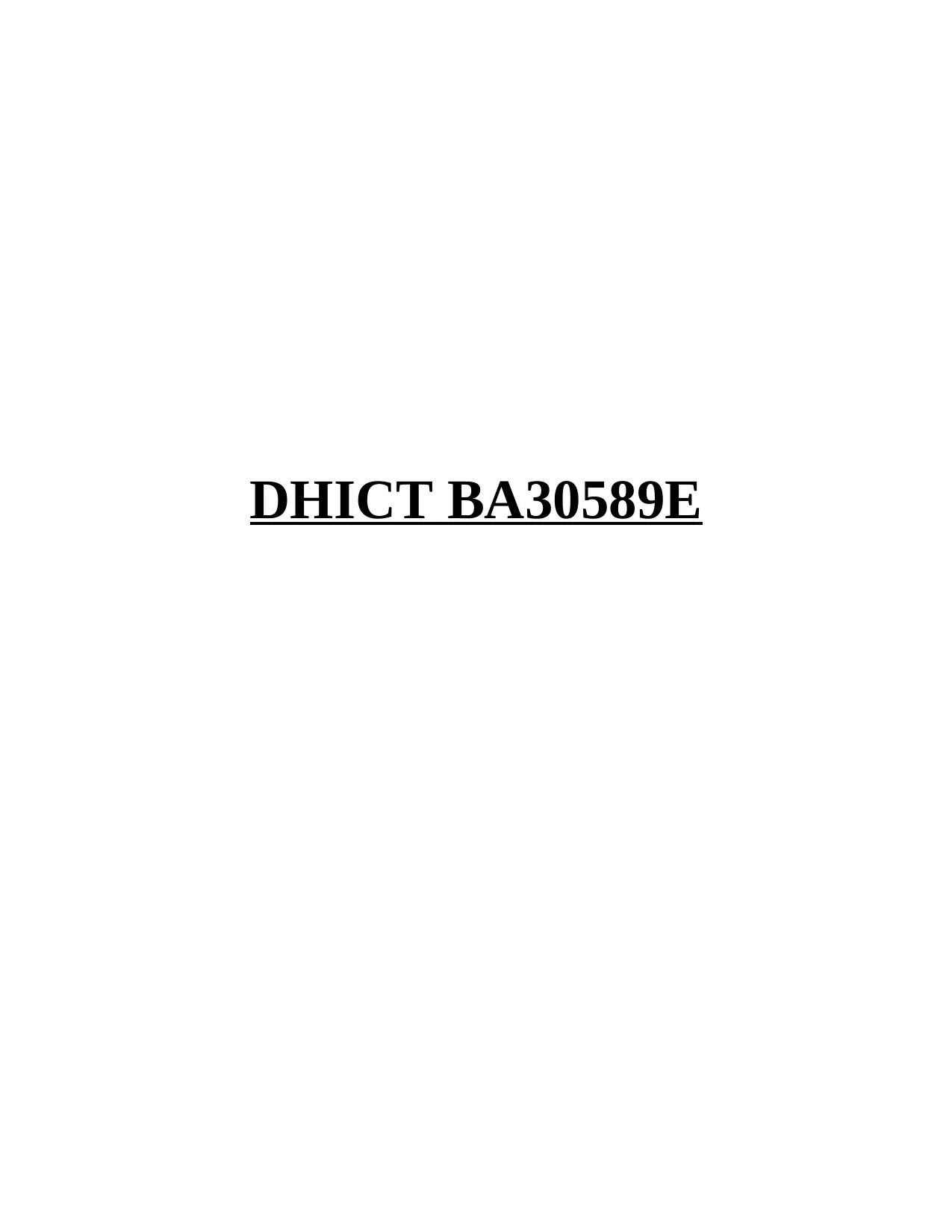
DHICT BA30589E
Paraphrase This Document
Need a fresh take? Get an instant paraphrase of this document with our AI Paraphraser
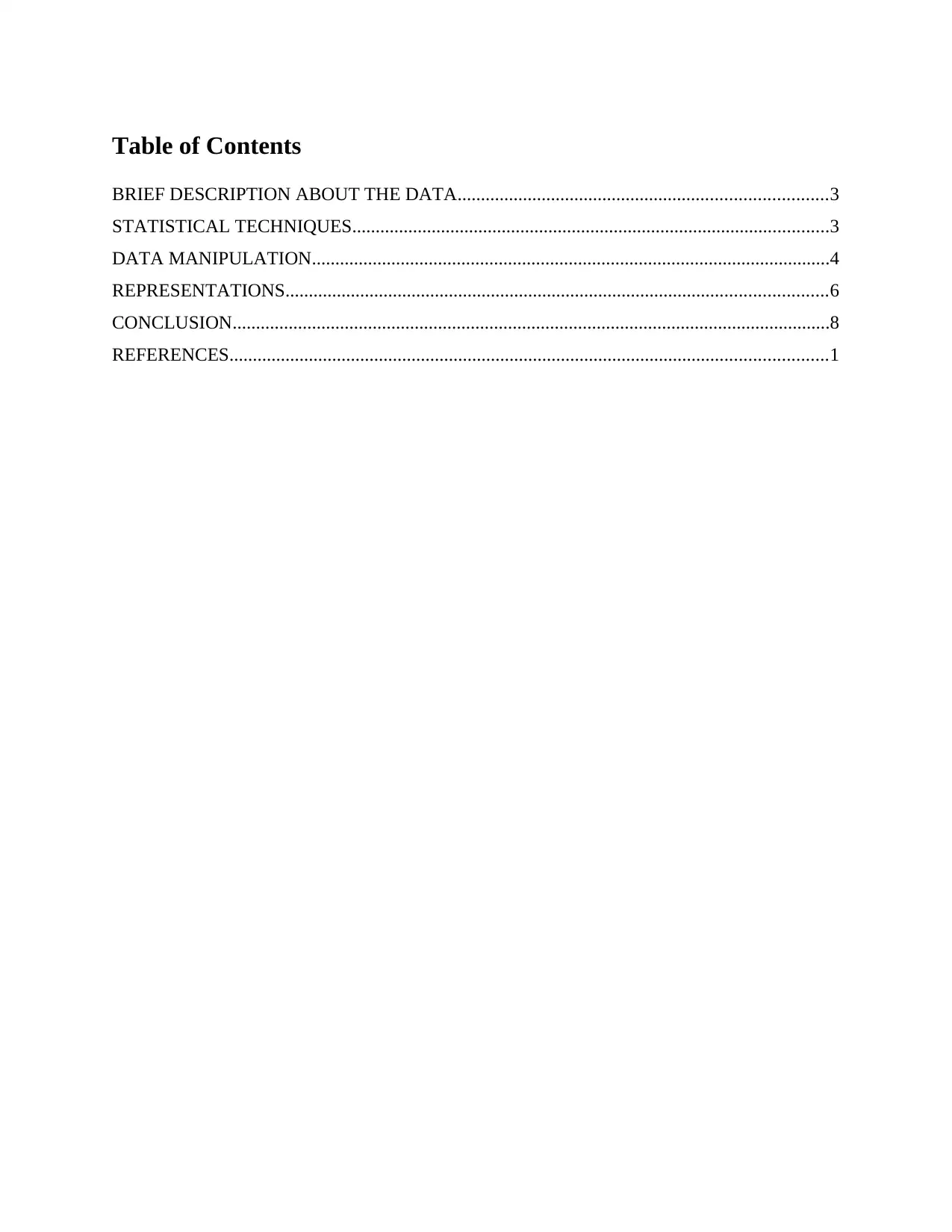
Table of Contents
BRIEF DESCRIPTION ABOUT THE DATA...............................................................................3
STATISTICAL TECHNIQUES......................................................................................................3
DATA MANIPULATION...............................................................................................................4
REPRESENTATIONS....................................................................................................................6
CONCLUSION................................................................................................................................8
REFERENCES................................................................................................................................1
BRIEF DESCRIPTION ABOUT THE DATA...............................................................................3
STATISTICAL TECHNIQUES......................................................................................................3
DATA MANIPULATION...............................................................................................................4
REPRESENTATIONS....................................................................................................................6
CONCLUSION................................................................................................................................8
REFERENCES................................................................................................................................1
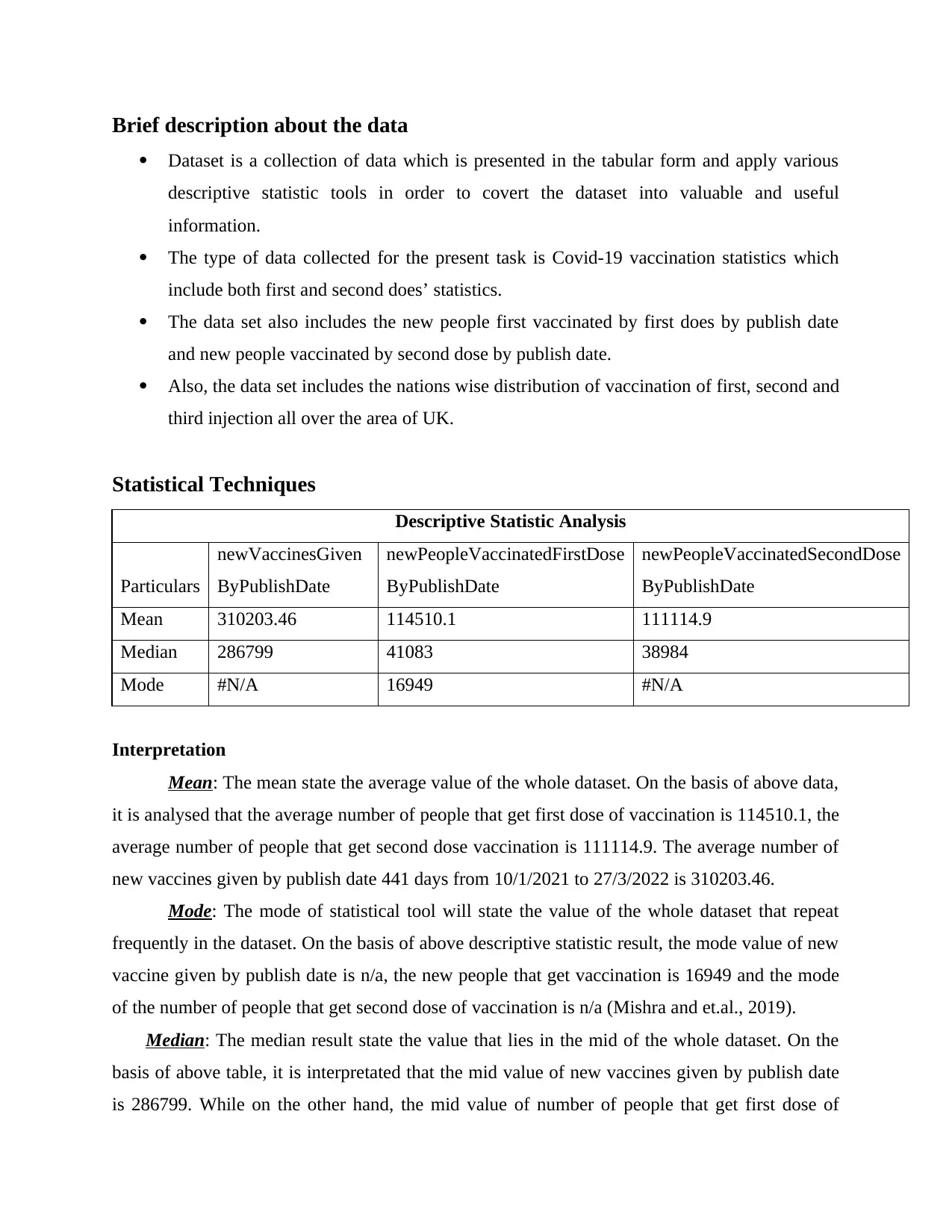
Brief description about the data
Dataset is a collection of data which is presented in the tabular form and apply various
descriptive statistic tools in order to covert the dataset into valuable and useful
information.
The type of data collected for the present task is Covid-19 vaccination statistics which
include both first and second does’ statistics.
The data set also includes the new people first vaccinated by first does by publish date
and new people vaccinated by second dose by publish date.
Also, the data set includes the nations wise distribution of vaccination of first, second and
third injection all over the area of UK.
Statistical Techniques
Descriptive Statistic Analysis
Particulars
newVaccinesGiven
ByPublishDate
newPeopleVaccinatedFirstDose
ByPublishDate
newPeopleVaccinatedSecondDose
ByPublishDate
Mean 310203.46 114510.1 111114.9
Median 286799 41083 38984
Mode #N/A 16949 #N/A
Interpretation
Mean: The mean state the average value of the whole dataset. On the basis of above data,
it is analysed that the average number of people that get first dose of vaccination is 114510.1, the
average number of people that get second dose vaccination is 111114.9. The average number of
new vaccines given by publish date 441 days from 10/1/2021 to 27/3/2022 is 310203.46.
Mode: The mode of statistical tool will state the value of the whole dataset that repeat
frequently in the dataset. On the basis of above descriptive statistic result, the mode value of new
vaccine given by publish date is n/a, the new people that get vaccination is 16949 and the mode
of the number of people that get second dose of vaccination is n/a (Mishra and et.al., 2019).
Median: The median result state the value that lies in the mid of the whole dataset. On the
basis of above table, it is interpretated that the mid value of new vaccines given by publish date
is 286799. While on the other hand, the mid value of number of people that get first dose of
Dataset is a collection of data which is presented in the tabular form and apply various
descriptive statistic tools in order to covert the dataset into valuable and useful
information.
The type of data collected for the present task is Covid-19 vaccination statistics which
include both first and second does’ statistics.
The data set also includes the new people first vaccinated by first does by publish date
and new people vaccinated by second dose by publish date.
Also, the data set includes the nations wise distribution of vaccination of first, second and
third injection all over the area of UK.
Statistical Techniques
Descriptive Statistic Analysis
Particulars
newVaccinesGiven
ByPublishDate
newPeopleVaccinatedFirstDose
ByPublishDate
newPeopleVaccinatedSecondDose
ByPublishDate
Mean 310203.46 114510.1 111114.9
Median 286799 41083 38984
Mode #N/A 16949 #N/A
Interpretation
Mean: The mean state the average value of the whole dataset. On the basis of above data,
it is analysed that the average number of people that get first dose of vaccination is 114510.1, the
average number of people that get second dose vaccination is 111114.9. The average number of
new vaccines given by publish date 441 days from 10/1/2021 to 27/3/2022 is 310203.46.
Mode: The mode of statistical tool will state the value of the whole dataset that repeat
frequently in the dataset. On the basis of above descriptive statistic result, the mode value of new
vaccine given by publish date is n/a, the new people that get vaccination is 16949 and the mode
of the number of people that get second dose of vaccination is n/a (Mishra and et.al., 2019).
Median: The median result state the value that lies in the mid of the whole dataset. On the
basis of above table, it is interpretated that the mid value of new vaccines given by publish date
is 286799. While on the other hand, the mid value of number of people that get first dose of
⊘ This is a preview!⊘
Do you want full access?
Subscribe today to unlock all pages.

Trusted by 1+ million students worldwide
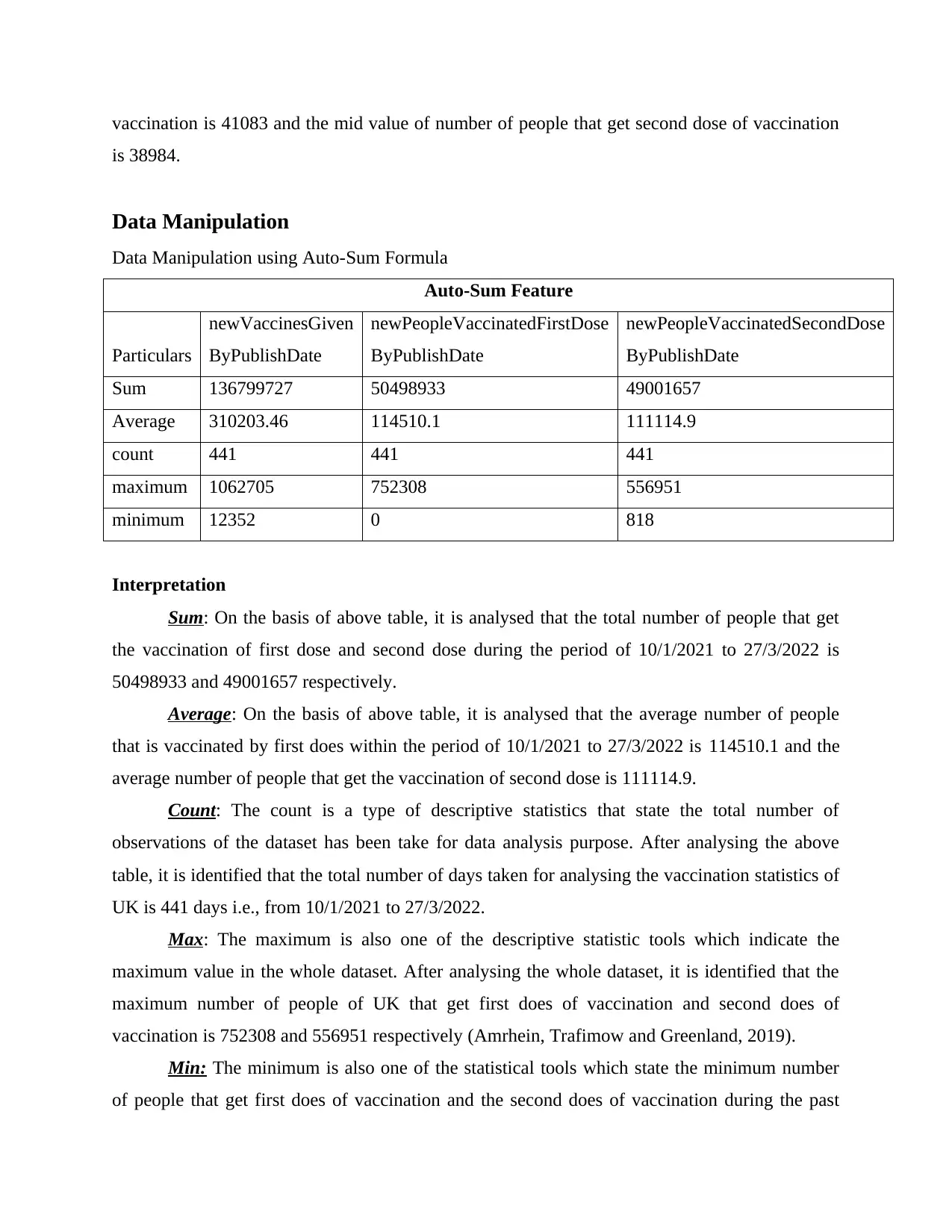
vaccination is 41083 and the mid value of number of people that get second dose of vaccination
is 38984.
Data Manipulation
Data Manipulation using Auto-Sum Formula
Auto-Sum Feature
Particulars
newVaccinesGiven
ByPublishDate
newPeopleVaccinatedFirstDose
ByPublishDate
newPeopleVaccinatedSecondDose
ByPublishDate
Sum 136799727 50498933 49001657
Average 310203.46 114510.1 111114.9
count 441 441 441
maximum 1062705 752308 556951
minimum 12352 0 818
Interpretation
Sum: On the basis of above table, it is analysed that the total number of people that get
the vaccination of first dose and second dose during the period of 10/1/2021 to 27/3/2022 is
50498933 and 49001657 respectively.
Average: On the basis of above table, it is analysed that the average number of people
that is vaccinated by first does within the period of 10/1/2021 to 27/3/2022 is 114510.1 and the
average number of people that get the vaccination of second dose is 111114.9.
Count: The count is a type of descriptive statistics that state the total number of
observations of the dataset has been take for data analysis purpose. After analysing the above
table, it is identified that the total number of days taken for analysing the vaccination statistics of
UK is 441 days i.e., from 10/1/2021 to 27/3/2022.
Max: The maximum is also one of the descriptive statistic tools which indicate the
maximum value in the whole dataset. After analysing the whole dataset, it is identified that the
maximum number of people of UK that get first does of vaccination and second does of
vaccination is 752308 and 556951 respectively (Amrhein, Trafimow and Greenland, 2019).
Min: The minimum is also one of the statistical tools which state the minimum number
of people that get first does of vaccination and the second does of vaccination during the past
is 38984.
Data Manipulation
Data Manipulation using Auto-Sum Formula
Auto-Sum Feature
Particulars
newVaccinesGiven
ByPublishDate
newPeopleVaccinatedFirstDose
ByPublishDate
newPeopleVaccinatedSecondDose
ByPublishDate
Sum 136799727 50498933 49001657
Average 310203.46 114510.1 111114.9
count 441 441 441
maximum 1062705 752308 556951
minimum 12352 0 818
Interpretation
Sum: On the basis of above table, it is analysed that the total number of people that get
the vaccination of first dose and second dose during the period of 10/1/2021 to 27/3/2022 is
50498933 and 49001657 respectively.
Average: On the basis of above table, it is analysed that the average number of people
that is vaccinated by first does within the period of 10/1/2021 to 27/3/2022 is 114510.1 and the
average number of people that get the vaccination of second dose is 111114.9.
Count: The count is a type of descriptive statistics that state the total number of
observations of the dataset has been take for data analysis purpose. After analysing the above
table, it is identified that the total number of days taken for analysing the vaccination statistics of
UK is 441 days i.e., from 10/1/2021 to 27/3/2022.
Max: The maximum is also one of the descriptive statistic tools which indicate the
maximum value in the whole dataset. After analysing the whole dataset, it is identified that the
maximum number of people of UK that get first does of vaccination and second does of
vaccination is 752308 and 556951 respectively (Amrhein, Trafimow and Greenland, 2019).
Min: The minimum is also one of the statistical tools which state the minimum number
of people that get first does of vaccination and the second does of vaccination during the past
Paraphrase This Document
Need a fresh take? Get an instant paraphrase of this document with our AI Paraphraser
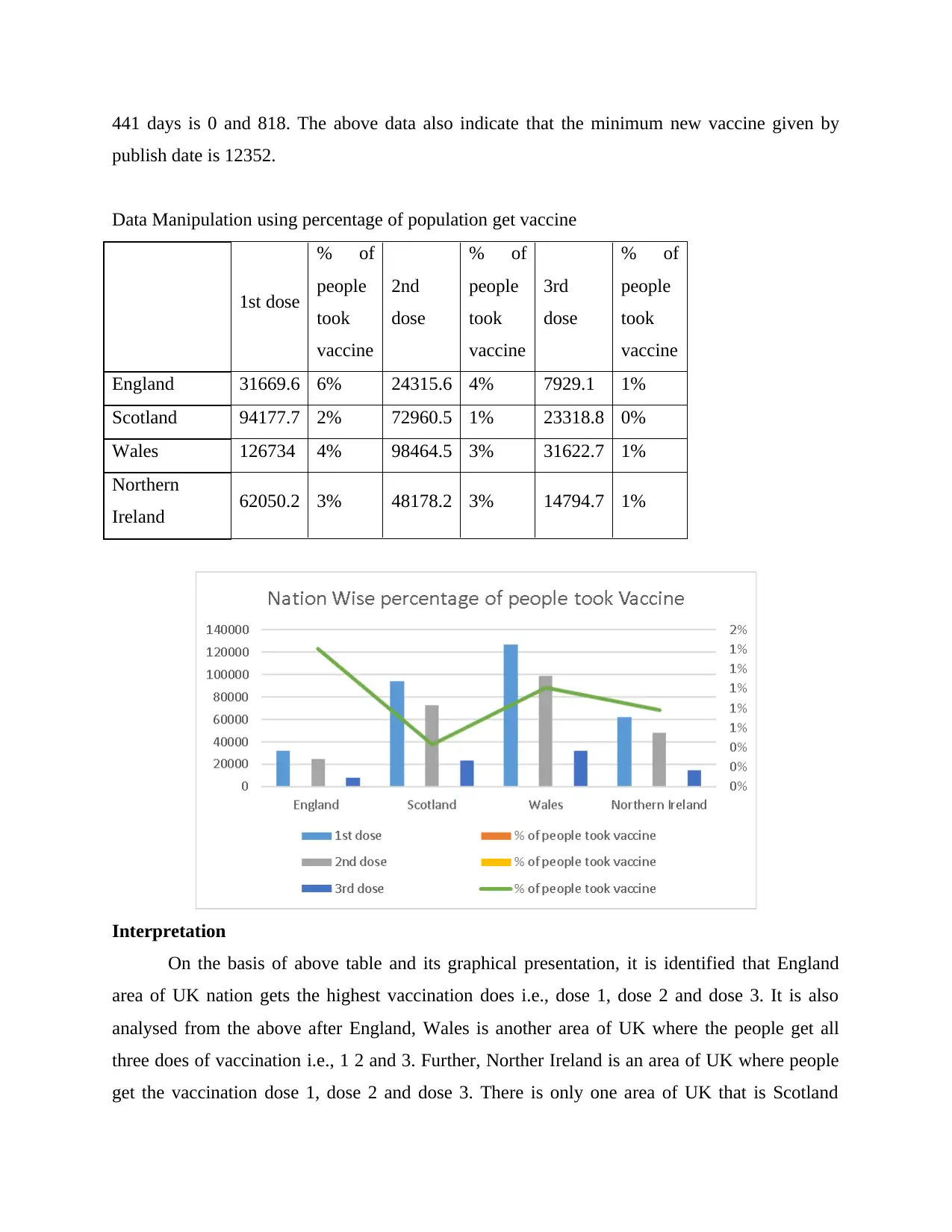
441 days is 0 and 818. The above data also indicate that the minimum new vaccine given by
publish date is 12352.
Data Manipulation using percentage of population get vaccine
1st dose
% of
people
took
vaccine
2nd
dose
% of
people
took
vaccine
3rd
dose
% of
people
took
vaccine
England 31669.6 6% 24315.6 4% 7929.1 1%
Scotland 94177.7 2% 72960.5 1% 23318.8 0%
Wales 126734 4% 98464.5 3% 31622.7 1%
Northern
Ireland 62050.2 3% 48178.2 3% 14794.7 1%
Interpretation
On the basis of above table and its graphical presentation, it is identified that England
area of UK nation gets the highest vaccination does i.e., dose 1, dose 2 and dose 3. It is also
analysed from the above after England, Wales is another area of UK where the people get all
three does of vaccination i.e., 1 2 and 3. Further, Norther Ireland is an area of UK where people
get the vaccination dose 1, dose 2 and dose 3. There is only one area of UK that is Scotland
publish date is 12352.
Data Manipulation using percentage of population get vaccine
1st dose
% of
people
took
vaccine
2nd
dose
% of
people
took
vaccine
3rd
dose
% of
people
took
vaccine
England 31669.6 6% 24315.6 4% 7929.1 1%
Scotland 94177.7 2% 72960.5 1% 23318.8 0%
Wales 126734 4% 98464.5 3% 31622.7 1%
Northern
Ireland 62050.2 3% 48178.2 3% 14794.7 1%
Interpretation
On the basis of above table and its graphical presentation, it is identified that England
area of UK nation gets the highest vaccination does i.e., dose 1, dose 2 and dose 3. It is also
analysed from the above after England, Wales is another area of UK where the people get all
three does of vaccination i.e., 1 2 and 3. Further, Norther Ireland is an area of UK where people
get the vaccination dose 1, dose 2 and dose 3. There is only one area of UK that is Scotland
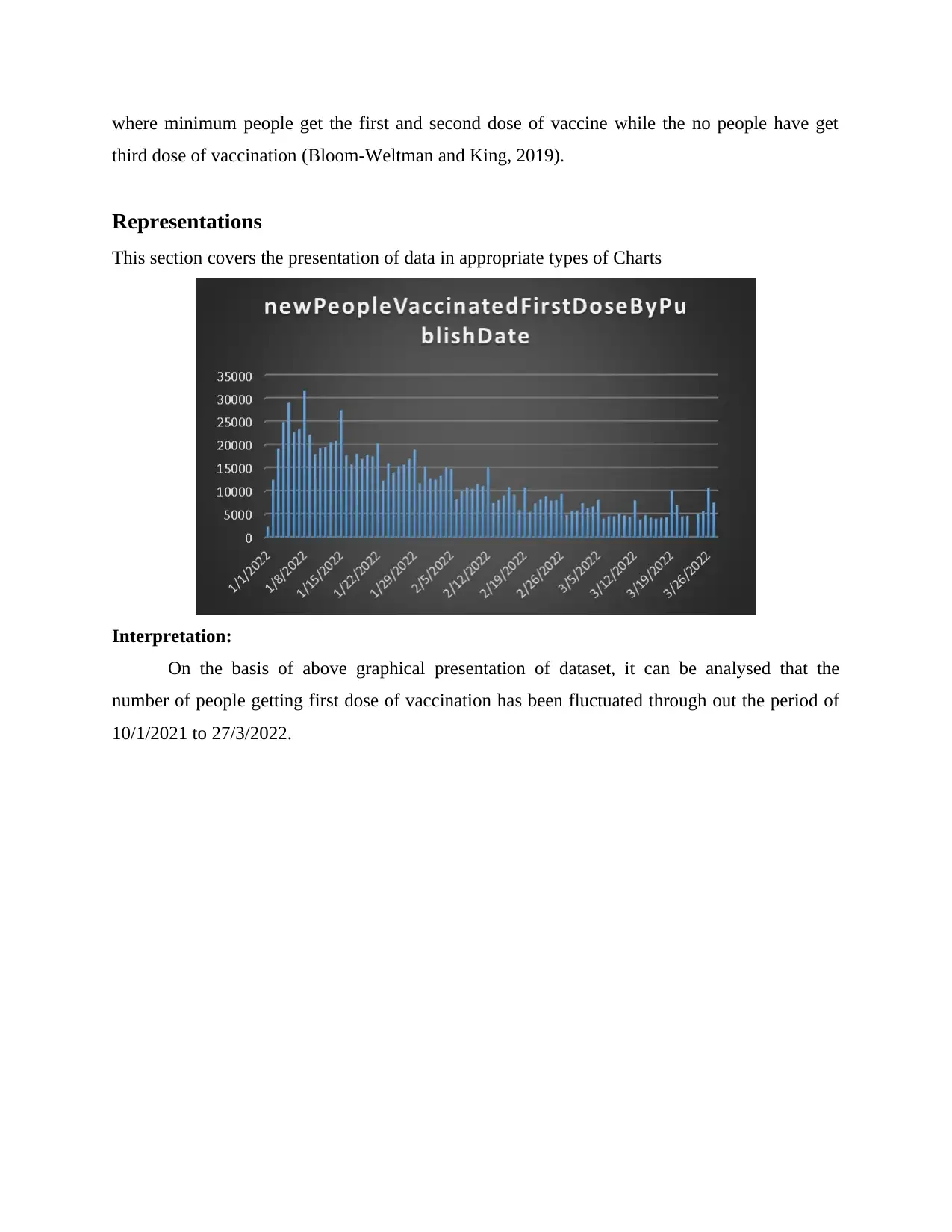
where minimum people get the first and second dose of vaccine while the no people have get
third dose of vaccination (Bloom-Weltman and King, 2019).
Representations
This section covers the presentation of data in appropriate types of Charts
Interpretation:
On the basis of above graphical presentation of dataset, it can be analysed that the
number of people getting first dose of vaccination has been fluctuated through out the period of
10/1/2021 to 27/3/2022.
third dose of vaccination (Bloom-Weltman and King, 2019).
Representations
This section covers the presentation of data in appropriate types of Charts
Interpretation:
On the basis of above graphical presentation of dataset, it can be analysed that the
number of people getting first dose of vaccination has been fluctuated through out the period of
10/1/2021 to 27/3/2022.
⊘ This is a preview!⊘
Do you want full access?
Subscribe today to unlock all pages.

Trusted by 1+ million students worldwide
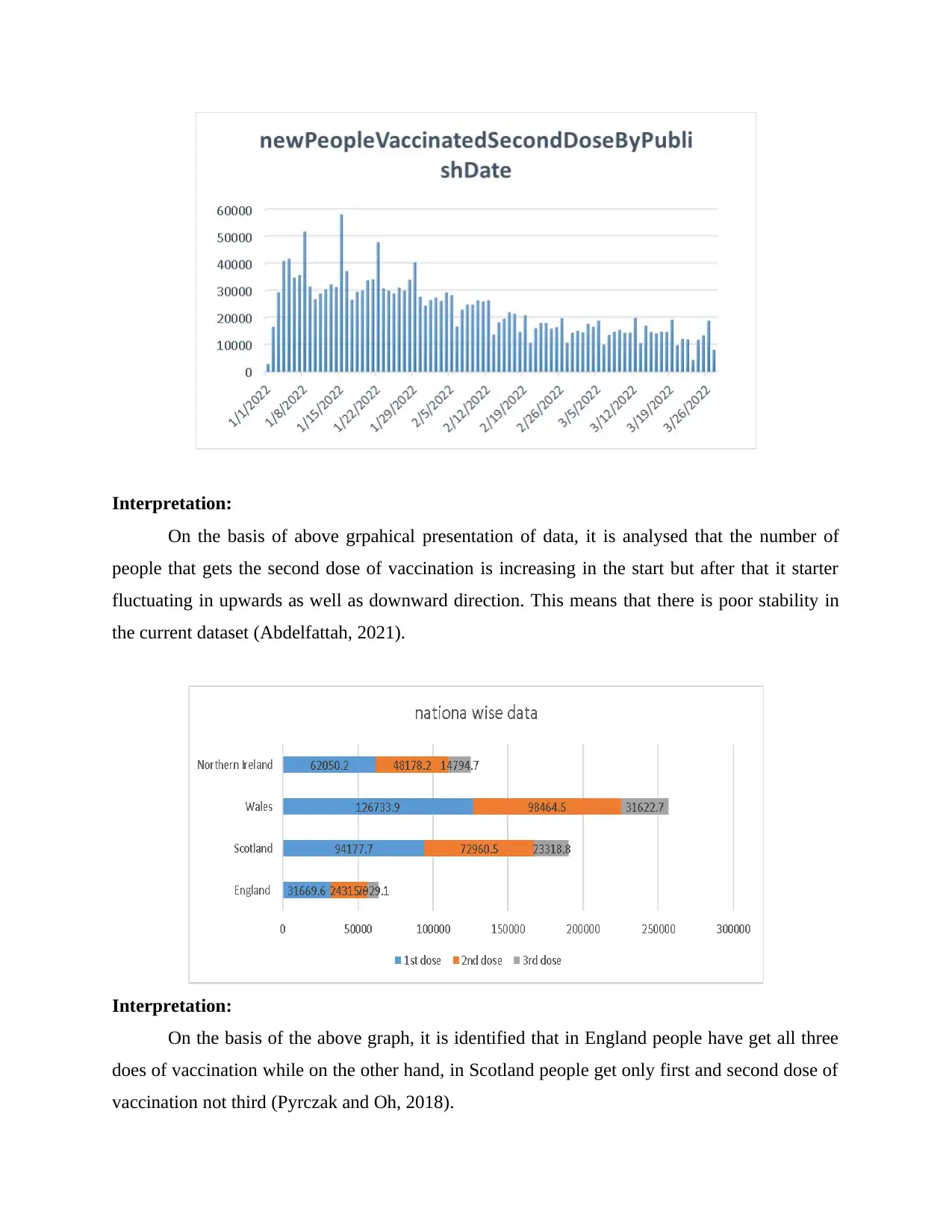
Interpretation:
On the basis of above grpahical presentation of data, it is analysed that the number of
people that gets the second dose of vaccination is increasing in the start but after that it starter
fluctuating in upwards as well as downward direction. This means that there is poor stability in
the current dataset (Abdelfattah, 2021).
Interpretation:
On the basis of the above graph, it is identified that in England people have get all three
does of vaccination while on the other hand, in Scotland people get only first and second dose of
vaccination not third (Pyrczak and Oh, 2018).
On the basis of above grpahical presentation of data, it is analysed that the number of
people that gets the second dose of vaccination is increasing in the start but after that it starter
fluctuating in upwards as well as downward direction. This means that there is poor stability in
the current dataset (Abdelfattah, 2021).
Interpretation:
On the basis of the above graph, it is identified that in England people have get all three
does of vaccination while on the other hand, in Scotland people get only first and second dose of
vaccination not third (Pyrczak and Oh, 2018).
Paraphrase This Document
Need a fresh take? Get an instant paraphrase of this document with our AI Paraphraser

CONCLUSION
After summing up the above information, it can be concluded that the people of UK have get
vaccination dose 1, 2 as well as 3. The report has also interpretated the result of descriptive
statistic and auto-sum feature which is computed in MS excel. Lastly, the report has been
interpretated and analysed the information as per the graphical presentation of the dataset.
After summing up the above information, it can be concluded that the people of UK have get
vaccination dose 1, 2 as well as 3. The report has also interpretated the result of descriptive
statistic and auto-sum feature which is computed in MS excel. Lastly, the report has been
interpretated and analysed the information as per the graphical presentation of the dataset.
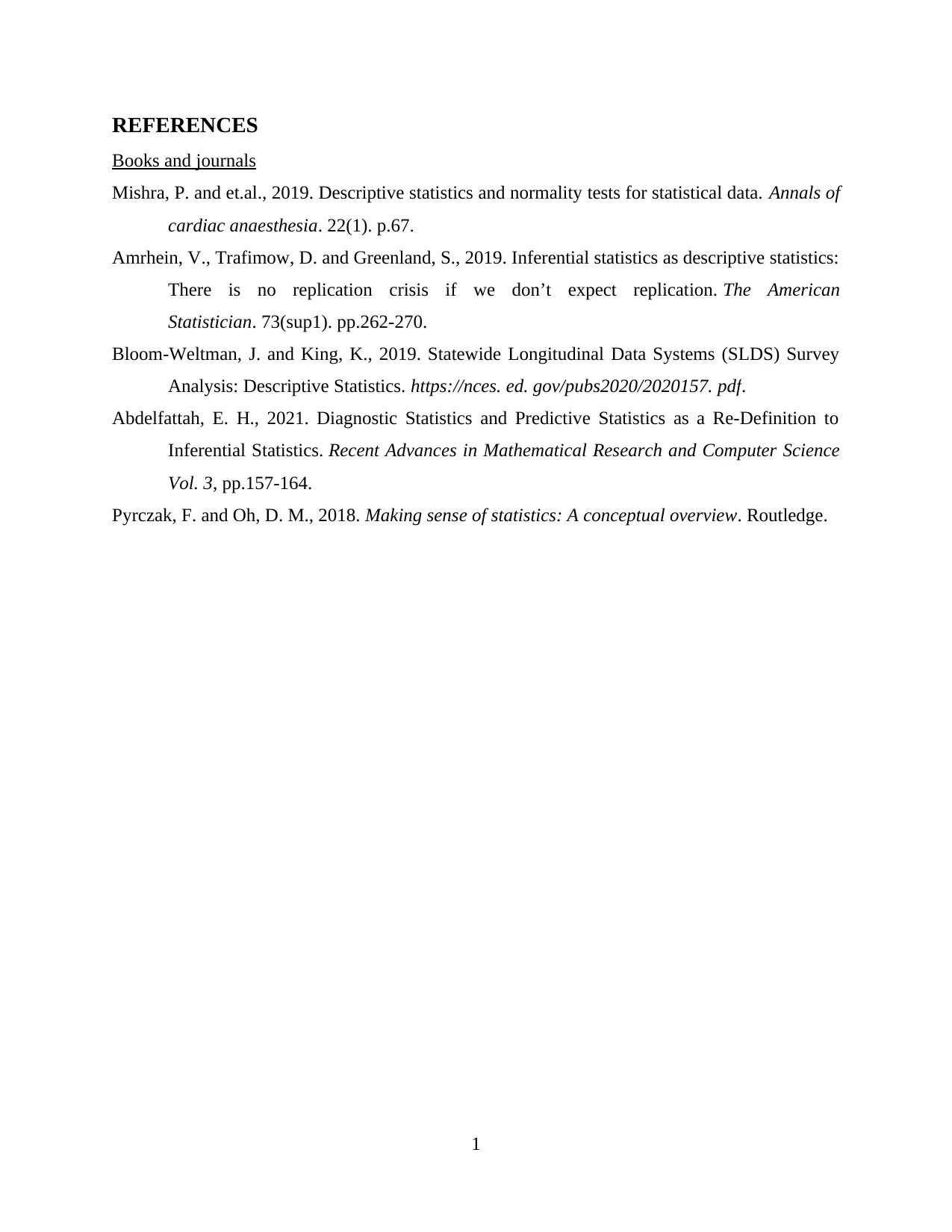
REFERENCES
Books and journals
Mishra, P. and et.al., 2019. Descriptive statistics and normality tests for statistical data. Annals of
cardiac anaesthesia. 22(1). p.67.
Amrhein, V., Trafimow, D. and Greenland, S., 2019. Inferential statistics as descriptive statistics:
There is no replication crisis if we don’t expect replication. The American
Statistician. 73(sup1). pp.262-270.
Bloom-Weltman, J. and King, K., 2019. Statewide Longitudinal Data Systems (SLDS) Survey
Analysis: Descriptive Statistics. https://nces. ed. gov/pubs2020/2020157. pdf.
Abdelfattah, E. H., 2021. Diagnostic Statistics and Predictive Statistics as a Re-Definition to
Inferential Statistics. Recent Advances in Mathematical Research and Computer Science
Vol. 3, pp.157-164.
Pyrczak, F. and Oh, D. M., 2018. Making sense of statistics: A conceptual overview. Routledge.
1
Books and journals
Mishra, P. and et.al., 2019. Descriptive statistics and normality tests for statistical data. Annals of
cardiac anaesthesia. 22(1). p.67.
Amrhein, V., Trafimow, D. and Greenland, S., 2019. Inferential statistics as descriptive statistics:
There is no replication crisis if we don’t expect replication. The American
Statistician. 73(sup1). pp.262-270.
Bloom-Weltman, J. and King, K., 2019. Statewide Longitudinal Data Systems (SLDS) Survey
Analysis: Descriptive Statistics. https://nces. ed. gov/pubs2020/2020157. pdf.
Abdelfattah, E. H., 2021. Diagnostic Statistics and Predictive Statistics as a Re-Definition to
Inferential Statistics. Recent Advances in Mathematical Research and Computer Science
Vol. 3, pp.157-164.
Pyrczak, F. and Oh, D. M., 2018. Making sense of statistics: A conceptual overview. Routledge.
1
⊘ This is a preview!⊘
Do you want full access?
Subscribe today to unlock all pages.

Trusted by 1+ million students worldwide
1 out of 9
Related Documents
Your All-in-One AI-Powered Toolkit for Academic Success.
+13062052269
info@desklib.com
Available 24*7 on WhatsApp / Email
![[object Object]](/_next/static/media/star-bottom.7253800d.svg)
Unlock your academic potential
Copyright © 2020–2025 A2Z Services. All Rights Reserved. Developed and managed by ZUCOL.




